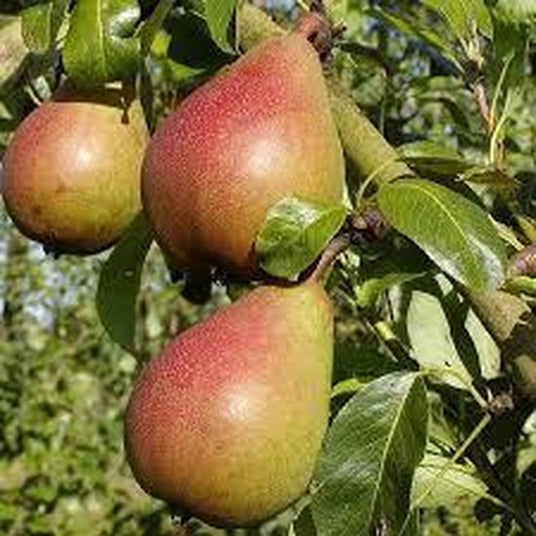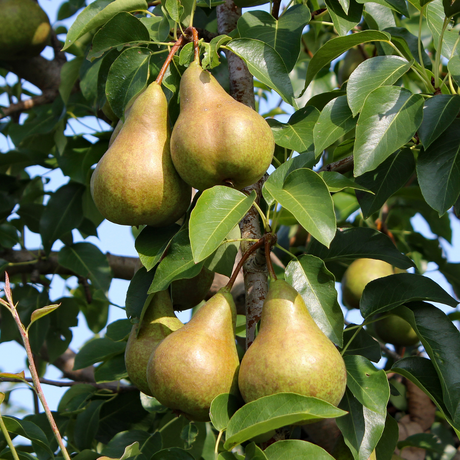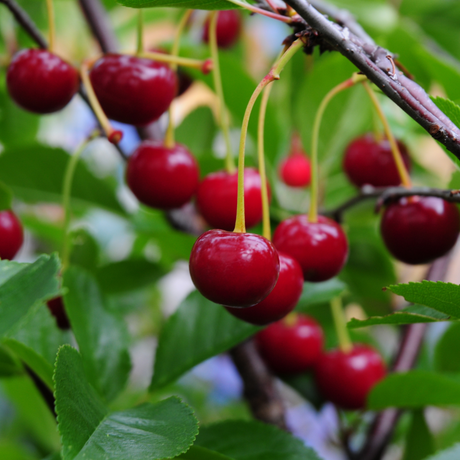Low-stem pear tree 'Doyenné du Comice' BIO
Regular price €27,72Unit priceUnavailableLow-stem pear tree 'Charneux' BIO
Regular price €27,72Unit priceUnavailableLow-stem pear tree 'Williams' BIO
Regular price €27,72Unit priceUnavailableLow-stem pear tree 'Bonne Louise d'Avranches' BIO
Regular price €27,72Unit priceUnavailablePear tree 'Doyenné du Comice' BIO
Regular price €27,72Unit priceUnavailable

Also read our fruit tree cultivation guide
Pear trees in pictures
In this video, Tom shows the collection of fruit trees for his new garden.
Our other fruit trees
View allBuy a pear tree: fragrance, color and a fresh harvest in your garden
Are you considering planting a pear tree (Pyrus communis)? That's an excellent idea. A pear tree not only offers a delicious fruit harvest but also enriches your garden with blossoms in spring, vibrant birdsong, and beautiful autumn colors. As an ornamental tree, the pear tree has a high decorative value, especially during its spring bloom. An old pear tree is also relatively low-maintenance, bears fruit quickly, and is a beautiful focal point in the garden. The blossoms and fruit of the pear tree differ from those of the apple tree, which often has white blossoms and requires different growing conditions. The pear fruit comes in various varieties and is known for its soft flesh and sweet flavor, with a wide range of uses, from eating fresh to incorporating into dishes. Within the pear family, there are also other trees, such as the nashi pear, quince, and ya pear, each with their own characteristics and uses.
At Plukkers, you can choose from trees ranging from standard to standard, to suit your garden and your needs. Did you know that pear trees can also be grown as espaliers? This is a space-saving option, ideal for smaller gardens, as these shapes take up less space. Standard pear trees have their first branches at around 170 centimeters and can grow up to 6 meters tall; their final size makes them suitable for larger gardens.
Pear trees grow best in full sun, where they can develop optimally and produce fruit. At harvest time, you'll enjoy the sweet fruits of the pear tree, prized for their juiciness and flavor.
Introduction: The magic of planting a pear tree in your garden
You know that feeling – you walk through your garden and dream of that one tree that makes everything complete. A pear tree is just such a tree, instantly bringing warmth, color, and life to your garden. Whether you choose a handful of low-stemmed pear trees that fit perfectly in your small garden, or dream of a stately tall-stemmed pear tree as a real eye-catcher, pear trees are simply an enrichment to any outdoor space. They not only treat you to delicious, juicy fruit in autumn, but also provide a magnificent display of blossoms in spring and a lush foliage in summer. Most pear trees are also very winter-hardy, so you can enjoy their presence for years to come, even when it's freezing outside.
Planting a pear tree? It's surprisingly easy, as long as you choose a spot with plenty of sunlight and well-draining soil. A layer of mulch around the trunk helps retain moisture and keep those pesky weeds at bay, so your tree can grow optimally. We prefer to plant in spring or fall—that's when you really give your pear tree the best start. With a little love and regular pruning, the tree will reward you with a bounty of fruit and healthy growth.
Pear trees come in all shapes and sizes, from compact, low-stemmed trees to impressive, tall-stemmed trees. There's sure to be a tree to suit your garden and your needs. Be aware, however: like other fruit trees, pear trees can sometimes be susceptible to pests and diseases. By keeping a close eye on your tree and taking action in time, you can keep it healthy and productive. With a little care and attention, a pear tree can produce delicious fruit for decades—an investment you'll enjoy season after season.
In this article, you'll discover everything you need to know about planting, pruning, caring for, and harvesting pear trees. Whether you're looking for the best tips for a bountiful harvest, want to know how to prevent pests, or simply want to enjoy the magic of a pear tree in your garden, you'll find all the answers here. Enjoy gardening!
What makes planting a pear tree a valuable addition?
- Healthy fruit : Pears are packed with antioxidants, fiber, vitamin C and flavonoids
- Natural attraction : spring blossoms attract bees and contribute to biodiversity
- Space-efficient : low-stem and columnar varieties take up little space and are therefore ideal for smaller gardens or even a balcony.
- Manageable maintenance : they grow well in "normal" garden soil and are reasonably hardy. Pear trees also require relatively little maintenance compared to other fruit trees. For optimal growth, pruning in late winter or early spring and following proper pruning techniques is recommended.
- Winter hardiness : pear trees are very winter hardy, which means they can withstand cold winters and are therefore suitable for our climate.
- Longevity : a pear tree can continue to produce fruit for decades
Pear tree varieties: discover your perfect match
You can choose from so many different pear trees that there's always one perfect for your garden. Do you have a small garden or just a balcony? Then a standard pear tree is exactly what you're looking for: compact, easy to care for, and yet full of delicious fruit. Standard pear trees have their first branches about 50 centimeters from the ground and are about 120 centimeters tall. I know people who even have one in a large pot on their patio. For those with more space, half-standard pear trees are ideal - they remain manageable but still produce a generous harvest. Half-standard pear trees have their first branches about 100 centimeters and can be kept small by pruning. And if you have a large garden and dream of such an impressive tree that you'll enjoy for years to come? Then go for a standard pear tree. It will grow into a truly magnificent specimen with sturdy branches that your grandchildren can enjoy for years to come. Stewing pears are a special variety you can choose if you want to stew pears; Well-known examples are Gieser Wildeman and Saint Remy.
It's helpful to think in advance about the best location for your pear tree and how big it will eventually grow. Pear trees are actually quite easy to grow: they prefer a sunny spot, sheltered from strong winds. The right location for pear trees should offer limited shade and plenty of sunlight. They also prefer well-drained soil that doesn't stagnate. The best time to plant a pear tree is after the leaves have fallen, usually in late autumn or winter, when the tree is dormant. Whether you plant a pear tree in a pot or directly in the garden, make sure it gets enough nutrients. A layer of mulch around the trunk works wonders – it retains moisture and protects the roots. Simple but effective. Pear trees need regular watering, especially in the first year after planting, to thrive. During dry spells, it's important to give them extra water. When planting a pear tree, it's important to dig a large hole and spread the roots out well to get a good start.
Most pear trees are real hardy and can easily withstand cold, but young trees sometimes need a little extra love during hard frosts. Pear trees are winter-hardy and can withstand temperatures below freezing. Regular pruning is important for a healthy tree and a good harvest. Pruning gives your tree a beautiful shape and helps it produce new branches and flower buds. Pruning pear trees should take place between November and March so the tree can recover and grow optimally. During pruning, it's important to remove side branches that grow inward or downward to keep the crown airy. Pruning larger branches also contributes to good shape and health. Pruning your pear tree is best done annually; this maintains the tree's vitality, promotes good spreading, and encourages fruit formation. Make sure to keep your tree pruned regularly for optimal growth and production. Regular pruning also helps prevent disease and improves air circulation. Also keep an eye out for pests or diseases—you'll often first spot them as dark spots on the leaves. Dark spots can indicate diseases like scab or pear rust. Check the leaves regularly for these symptoms so you can intervene quickly. If you check your tree regularly and take action in time, it will remain vital and productive for years to come.
In spring, your pear tree will flourish again, and you'll really get your money's worth: it transforms into a cloud of white flowers. These flowers are not only beautiful to look at, but they also attract all the bees and other beneficial creatures to your garden. And without those visitors, you wouldn't get any fruit, so such a vibrant garden is a real bonus. Depending on the variety you choose and the weather, you can enjoy your own harvest in the fall. Pear trees usually begin to bear fruit when they are three to five years old. Whether you choose a juicy eating pear or a stewing pear for warm compote, with a little TLC, your pear tree will provide you with years of fresh fruit and plenty of gardening joy.
For healthy growth and fruit production, it's important that your pear tree gets enough nutrients. Fertilize the tree in spring and use products specifically formulated for fruit trees to support its health and production. This ensures your tree gets all the nutrients it needs for a bountiful harvest.
Our recommendations from the low-stem pear tree collection
Our range includes the right product for every garden: from classic pear trees to unique varieties. To keep these trees healthy, we also offer various care products, such as fertilizers and pesticides. Preventative treatments are recommended for the development of diseases like pear rust and scab.
- Pear tree 'Bonne Louise d'Avranches' BIO (low stem) – large, aromatic pears and an elegant silhouette
- Pear tree 'Doyenné du Comice' BIO (low stem) – creamy dessert pear with a luxurious texture, also suitable for more compact gardens
- Low-stem pear tree 'Charneux' BIO (low-stem) - 'Charneux' is a classic pear variety that produces medium-sized, juicy pears with a sweet, aromatic flavour and a fine texture.
- Low-stem pear tree 'Williams' BIO (low-stem) - 'Williams' is a classic. The fruits are delicious to eat fresh and also suitable for juice, desserts and jam.
Pollination: Self-pollination or cross-pollination for sweet fruits?
Although some varieties can self-pollinate, one or two additional trees usually results in a better yield. Choose varieties with similar flowering times for optimal cross-pollination, or combine a self-pollinator with a suitable partner. When pruning, ensure light reaches the canopy to produce beautiful, large pears. Planting several pear varieties that flower simultaneously can significantly increase yield.
Planting and care tips and pruning pear trees
Planting a pear tree requires careful consideration. It's best to plant a pear tree when it has shed its leaves and is dormant, usually in winter. This is the ideal time to ensure the tree establishes well. When planting a pear tree, pay attention to the correct method and conditions.
- Planting time : Choose autumn or early spring (without frost) and ensure the tree is planted correctly. Pear trees are best planted in winter, from November to April, after the leaves have fallen.
- Location : Choose a spot with plenty of sunlight, in healthy, well-drained and fertile soil.
- Planting distance : take into account the final size of the tree (3–5 m for low-stemmed trees; narrower rows for columnar trees), so that each tree has sufficient space to grow.
- Pruning : open the crown in winter; after flowering you can also prune lightly.
- Watering & feeding : Water young trees extra; fertilize annually with compost or organic fertilizer in spring. Make sure the tree gets enough nutrients, because only with sufficient nutrients can a pear tree grow healthily and produce good fruit. Adding lime to the soil in February helps keep the pear tree healthy.
- Variety selection : when choosing a variety, pay attention to the hardiness of the pear tree, so that it can also survive well in colder climates.
Harvesting, using and storing
Pear harvesting time is usually between September and early October, depending on the variety. Harvest the fruit as soon as it darkens and becomes light-colored; a healthy pear tree will then produce tasty, sweet fruit. When inspecting the fruit, look for dark spots, as these can indicate disease or damage. The autumn pear Conference is usually ripe from October to early November. The popular summer pear Williams Christ can be harvested from mid-August to October. Use the pears fresh, in desserts, compotes, or chutneys—they are delicious in all sorts of dishes. For stewing, there are special varieties, known as stewing pears, such as Gieser Wildeman and Saint Remy, which turn red when cooked. They can be stored in a cool, dark place, often for several weeks to months, depending on the variety; the final product depends on the storage method chosen.
Your fruit tree, your investment
A pear tree is more than just fruit: it's a seasonal experience, nature in your garden, and healthy nutrition all rolled into one. With the right choice—from standard to columnar—it fits almost anywhere. Start your own pear tree at Plukkers today and enjoy years of pure gardening pleasure.















